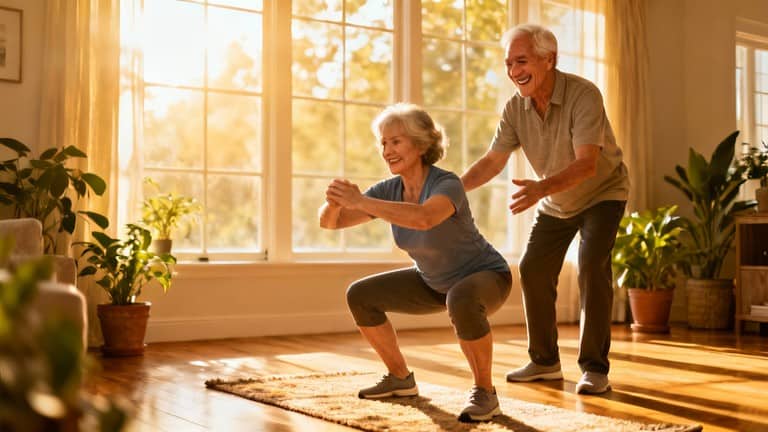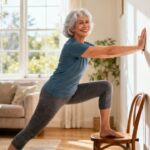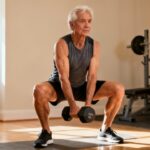Have you ever paused to imagine how your body might feel a decade from now? After age 50, it’s common to lose muscle mass each year, which can slowly make everyday tasks like climbing stairs or getting up from a chair more challenging.
The good news is that a few simple exercises can make a huge difference. In this article, you’ll learn three foundational moves that help you maintain strength, improve balance, and live with greater confidence.
1. Push-Ups: Rebuild Upper Body Strength Safely
Push-ups are a powerful exercise for preserving muscle and bone density. They target your chest, shoulders, arms, and core, which are essential for good posture and daily activities.
How to Do a Standard Push-Up
- Start in a high plank with hands slightly wider than your shoulders.
- Keep your body in a straight line from head to heels.
- Lower your chest toward the floor, elbows at a 45-degree angle.
- Exhale and push back up to the starting position.
Aim for 2–3 sets of 5–10 reps, resting 30–60 seconds between sets.
Easy Modifications for Any Fitness Level
- Wall Push-Ups: Stand arm’s length from a wall and push against it. Ideal for beginners or those with wrist issues.
- Knee Push-Ups: Perform the movement with knees on the ground to reduce load.
- Incline Push-Ups: Use a countertop or bench for a gentler version that still builds strength.
If you have shoulder injuries, wrist arthritis, or high blood pressure, consult a doctor first. Always prioritize proper form over speed.
2. Planks: Strengthen Your Core for Better Stability
Your core muscles support your spine, hips, and pelvis, helping prevent back pain and falls. Planks are a simple yet effective way to build this foundational strength.
How to Hold a Proper Plank
- Begin on your hands and knees.
- Step feet back to form a straight line from head to heels.
- Engage your core and glutes, keeping hips level.
- Hold for 15–30 seconds while breathing steadily.
Start with 2–3 sets, focusing on form rather than duration.
Beginner-Friendly Modification
Try the knee plank: Drop both knees to the floor while maintaining a straight line from knees to head. Use a cushion for comfort if needed.
Avoid planks if you have active back pain or recent surgery. Practice 3–5 times per week with rest days in between.
3. Squats: Power Your Legs for Everyday Independence
Squats strengthen your glutes, hamstrings, and quads, making it easier to stand, walk, and climb stairs. They’re a key movement for maintaining mobility and reducing joint pain.
How to Perform a Bodyweight Squat
- Stand with feet shoulder-width apart, toes slightly out.
- Keep your chest up and core engaged.
- Bend knees and push hips back as if sitting in a chair.
- Lower as far as comfortable, heels on the ground.
- Push through heels to return to standing.
Do 2–3 sets of 8–12 reps, resting 30–60 seconds between sets.
Simplified Version: Chair Squats
Stand in front of a chair and lower yourself until you lightly tap the seat with your glutes, then push up. This reduces joint strain while building strength.
If you have knee or hip issues, hold onto a wall for support. Squat 2–4 times weekly, listening to your body’s signals.
Rest and Recovery: Let Your Body Heal and Grow Stronger
Strength improves during rest, not just exercise. Allow at least one day between workouts for muscle repair. Gentle stretching and 8 hours of sleep nightly support recovery and reduce stiffness.
Nutrition: Fuel Your Body for Long-Term Health
Pair these exercises with a balanced diet rich in lean protein, calcium, vitamin D, and anti-inflammatory foods. Stay hydrated to support muscle function and overall vitality.
Start Small, Stay Consistent, and Reclaim Your Strength
Aging doesn’t have to mean decline. By incorporating push-ups, planks, and squats into your routine, you’re investing in a future filled with energy and independence.
You don’t need a gym or hours of time—just a few minutes each day can transform how you feel. Begin today, and celebrate every step toward a stronger, pain-free life.








